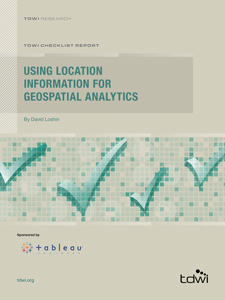
TDWI Checklist Report | Using Location Information for Geospatial Analytics
September 26, 2012
Despite the purported decline in brick-and-mortar commerce in connection with the growth of virtual businesses, online companies, and electronic commerce, location still matters. All business transactions still take place with individuals in specific places. As companies seek to improve profits, reduce costs, or increase productivity from the “virtualized space” of the World Wide Web, they are rapidly mainstreaming geospatial analytics. Ever-growing data volumes are rife with geographic information that can be used to reveal fascinating insights about the location of events, transactions, and behaviors.
Whether you are seeking operational efficiencies, revenue growth, or more effective management, many individual decisions can be informed on a minute-by-minute basis through geospatial analytics and location-based intelligence. In this TDWI Checklist Report, we review the alignment of geospatial information with the business intelligence environment and provide suggestions for capturing location information and differentiating between deliverable addresses and geolocations. We review core information management practices to link location information and geospatial analysis to demographic data, including customer profiles, transaction histories, and ways of influencing decision-making based on a combination of reporting, analysis, and location information.
Geospatial analysis services are used to explore:
- Characteristics and behaviors of objects (such as individuals, members of a logical cohort or community of interest, businesses, points of interest, or geographic regions)
- These objects’ location attributes (such as average age, median income, average driving distance, or average education)
- Temporal events within a number of application scenarios
This combined location-based intelligence informs operational and analytical applications, workflows, and decision-making, and can add value by increasing revenues, decreasing costs, or improving productivity and satisfaction. Download the report to learn more.